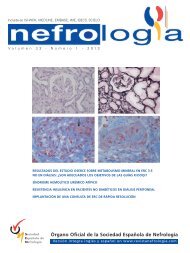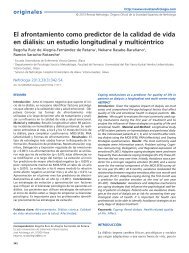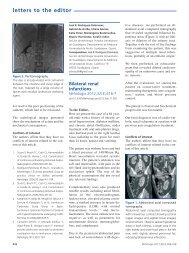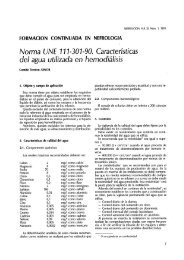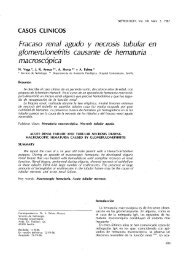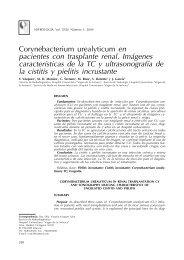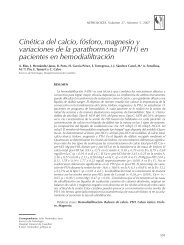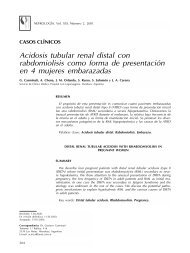PDF Número - NefrologÃa
PDF Número - NefrologÃa
PDF Número - NefrologÃa
Create successful ePaper yourself
Turn your PDF publications into a flip-book with our unique Google optimized e-Paper software.
evisión corta<br />
Marcin Adamczak et al. Ischemic nephropathy<br />
prolonged periods of vasoconstriction which leads to<br />
permanent structural changes in the microcirculation. 27 Since<br />
microvascular remodeling correlates with the renal scarring,<br />
it may have an important implication on CKD progression in<br />
atherosclerotic renovascular disease. 28<br />
The severity of histopathological damage in renal<br />
parenchyma is an important determinant of renal outcome<br />
in patients with ischemic nephropathy. Wright et al.<br />
investigated the impact of histological lesions on renal<br />
functional outcome in a small group of patients whose<br />
renal biopsies suggested ischemic nephropathy, irrespective<br />
of whether significant RAS has been demonstrated in<br />
angiography. 29 The authors found a tight relationship<br />
between decreases in estimated GFR (eGFR) over time and<br />
renal damage score. 29<br />
PATHOGENESIS<br />
The pathogenesis of ischemic nephropathy is more<br />
complex than just narrowing of the renal artery from<br />
atherosclerosis. In contrast to the results from the animal<br />
experiments (for example Goldblatt hypertension in dogs<br />
induced by clamp to the renal artery) in which RAS is<br />
accompanied by the intact renal vascular tree, in humans<br />
with atherosclerotic RAS the renal vasculature is often<br />
damaged. Therefore in animal model GFR decrease due to<br />
RAS is the reversible phenomenon. In contrast, in the<br />
majority of patients with atherosclerotic RAS, due to<br />
irreversibility of vascular and interstitial lesions, GFR<br />
decrease is irreversible.<br />
Although ischemic nephropathy is caused by RAS, the<br />
relationship between RAS intensity and presence of<br />
ischemic nephropathy or the severity of renal dysfunction<br />
is weak. In a study of 71 patients with atherosclerotic<br />
RAS, Suresh et al. found that renal function was equally<br />
decreased in patients with mild proximal renovascular<br />
disease as in those with severe RAS. 30 Similarly, Cheung et<br />
al. assessed time of progression to CKD stage 5 in patients<br />
with unilateral atherosclerotic renal artery occlusion and<br />
contralateral 50% RAS. 31 Irrespective of<br />
whether the nonocluded artery was normal or had stenosis<br />
of varying significance, time to starting renal replacement<br />
therapy or death did not correlate with renovascular<br />
anatomy. 31 The most likely explanation of these<br />
observations is that decrease of GFR in patients with RAS<br />
is mainly not determined by severity of RAS, but to the<br />
extend kidney lesions downstream of the RAS. It seems<br />
that reduction of the kidney length may be a better<br />
indicator of progression of ischemic nephropathy than the<br />
degree of RAS. As much as renal atrophy can be attributed<br />
to lack of blood flow, changes in kidney size seems to be<br />
more reasonable outcome measure of the effect of<br />
reduction of blood flow.<br />
434<br />
The kidneys physiologically receive relative blood supply<br />
three to five fold higher than heart or liver. It seems that in<br />
kidneys perfusion pressure below 70-80mmHg (correlates<br />
with >70% of RAS) overcome adaptive mechanisms and<br />
lead to hypoxia. However pathological changes do not<br />
appear to be directly related to the parenchymal tissue<br />
hypoxia. Patients with ischemic nephropathy are<br />
heterogeneous with respect to the degree of hypoxia in<br />
kidney tissue. In the early stages of ischemic nephropathy<br />
renal hypoxia in viable tissues seems to be present.<br />
Experimental study in pigs, showed during acute RAS, a<br />
decrease of regional intrarenal tissue oxygenation (measured<br />
directly with oxygen electrodes). Result of this experimental<br />
study confirmed the existence of hypoxia in kidney tissues. 32<br />
In contrast to this experimental observations, some recently<br />
performed clinical studies in the later stages of the disease,<br />
did not confirm the presence of hypoxia in the kidney tissue<br />
of patients with ischemic nephropathy. Renal tissue<br />
oxygenation was analyzed in patients with RAS by blood<br />
oxygen level-dependent magnetic resonance imaging<br />
(BOLD-MRI) technique. This technique uses the<br />
paramagnetic properties of desoxygenated hemoglobin.<br />
During oxygen extraction from the blood, increasing tissue<br />
concentrations of desoxygenated hemoglobin led to a<br />
decrease of transverse relaxation time (T2*) and an increase<br />
in the rate of spin dephasing (R2*). 33,34 Based on the<br />
estimation of these parameters, tissue oxygenation can be<br />
visualized. With this technique Gloviczki et al. studied<br />
patients with RAS accompanied by reduction volume of<br />
kidney downstream to RAS. 35 In this study, they<br />
demonstrated preserved medullary and cortical tissue<br />
oxygenation. It may be caused by the decrease of oxygen<br />
consumption by failed kidney. In the other study,<br />
measurement of oxygen tension in the renal veins of patients<br />
with RAS, also did not demonstrate desaturation. 36<br />
The preserved tissue oxygenation in kidney with RAS is<br />
manifested by normal plasma erythropoietin concentration in<br />
its renal vein. 37 Based on the above mentioned data, it may be<br />
proposed that in the early stages, renal hypoxia plays a crucial<br />
role in the pathogenesis of ischemic nephropathy. However, in<br />
the later stages, tubulointerstitial fibrosis dominates. 38<br />
Renal hypoperfusion, leads to increased secretion of renin and<br />
generation of angiotensin II (Ang II). 39 Recent studies<br />
confirmed that stenosis must be advanced in order to determine<br />
the hemodynamic effect. Careful studies using expanded<br />
balloons in humans indicate that an aortic–renal gradient<br />
exceeding 25 mmHg is necessary to increase renin secretion. 39<br />
This coincides with cross-sectional vascular occlusion<br />
approaching 70–80%. Ang II increases the expression of the<br />
transforming growth factor β‚ (TGF-β) and platelet-derived<br />
growth factor-B (PDGF-B), resulting in the accumulation of<br />
extracellular matrix and collagen type IV in the perivascular<br />
tissue, interstitium and finally in the glomeruli (Figure 1). 22,40<br />
Nefrologia 2012;32(4):432-38



